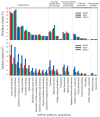The Composition and Primary Metabolic Potential of Microbial Communities Inhabiting the Surface Water in the Equatorial Eastern Indian Ocean
- PMID: 33810062
- PMCID: PMC8005183
- DOI: 10.3390/biology10030248
The Composition and Primary Metabolic Potential of Microbial Communities Inhabiting the Surface Water in the Equatorial Eastern Indian Ocean
Abstract
Currently, there is scant information about the biodiversity and functional diversity of microbes in the eastern Indian Ocean (EIO). Here, we used a combination of high-throughput sequencing of 16S rRNA genes and a metagenomic approach to investigate the microbial population structure and its metabolic function in the equatorial EIO. Our results show that Cyanobacterial Prochlorococcus made up the majority of the population. Interestingly, there were fewer contributions from clades SAR11 (Alphaproteobacteria) and SAR86 (Gammaproteobacteria) to microbial communities than contributions from Prochlorococcus. Based on functional gene analysis, functional genes rbcL, narB, and nasA were relatively abundant among the relevant genes. The abundance of Prochlorococcus implies its typically ecological adaptation in the local ecosystem. The microbial metabolic potential shows that in addition to the main carbon fixation pathway Calvin cycle, the rTCA cycle and the 3-HP/4-HB cycle have potential alternative carbon fixation contributions to local ecosystems. For the nitrogen cycle, the assimilatory nitrate and nitrite reduction pathway is potentially the crucial form of nitrogen utilization; unexpectedly, nitrogen fixation activity was relatively weak. This study extends our knowledge of the roles of microbes in energy and resource cycling in the EIO and provides a foundation for revealing profound biogeochemical processes driven by the microbial community in the ocean.
Keywords: Prochlorococcus; eastern Indian Ocean; metagenome; microbial community; microbial metabolism.
Conflict of interest statement
The authors declare no conflict of interest.
Figures






Similar articles
-
Metagenomic Analysis Reveals Microbial Community Structure and Metabolic Potential for Nitrogen Acquisition in the Oligotrophic Surface Water of the Indian Ocean.Front Microbiol. 2021 Feb 18;12:518865. doi: 10.3389/fmicb.2021.518865. eCollection 2021. Front Microbiol. 2021. PMID: 33679623 Free PMC article.
-
The potential contribution of microbial communities to carbon fixation and nitrogen cycle in the Eastern Indian Ocean.Mar Environ Res. 2025 May;207:107056. doi: 10.1016/j.marenvres.2025.107056. Epub 2025 Mar 6. Mar Environ Res. 2025. PMID: 40054424
-
Heterotrophic Bacteria Dominate the Diazotrophic Community in the Eastern Indian Ocean (EIO) during Pre-Southwest Monsoon.Microb Ecol. 2019 Nov;78(4):804-819. doi: 10.1007/s00248-019-01355-1. Epub 2019 Apr 29. Microb Ecol. 2019. PMID: 31037377
-
The response of the marine nitrogen cycle to ocean acidification.Glob Chang Biol. 2018 Nov;24(11):5031-5043. doi: 10.1111/gcb.14424. Epub 2018 Sep 26. Glob Chang Biol. 2018. PMID: 30120863
-
Ecological Energetic Perspectives on Responses of Nitrogen-Transforming Chemolithoautotrophic Microbiota to Changes in the Marine Environment.Front Microbiol. 2017 Jul 14;8:1246. doi: 10.3389/fmicb.2017.01246. eCollection 2017. Front Microbiol. 2017. PMID: 28769878 Free PMC article. Review.
Cited by
-
Underlying mechanisms of spatial distribution of prokaryotic community in surface seawater from Arctic Ocean to the Sea of Japan.Microbiol Spectr. 2025 Jul;13(7):e0051725. doi: 10.1128/spectrum.00517-25. Epub 2025 May 30. Microbiol Spectr. 2025. PMID: 40444437 Free PMC article.
-
Depth-dependent microbial metagenomes sampled in the northeastern Indian Ocean.Sci Data. 2024 Jan 18;11(1):88. doi: 10.1038/s41597-024-02939-4. Sci Data. 2024. PMID: 38238332 Free PMC article.
-
Subsurface Bacterioplankton Structure and Diversity in the Strongly-Stratified Water Columns within the Equatorial Eastern Indian Ocean.Microorganisms. 2023 Feb 26;11(3):592. doi: 10.3390/microorganisms11030592. Microorganisms. 2023. PMID: 36985166 Free PMC article.
-
Monthly Variation, Environmental Drivers, and Ecological Functions of Marine Bacterial Community in a Eutrophic Coastal Area of China.Microorganisms. 2025 Apr 7;13(4):837. doi: 10.3390/microorganisms13040837. Microorganisms. 2025. PMID: 40284674 Free PMC article.
References
-
- Six K.D., Maier-Reimer E. Effects of plankton dynamics on seasonal carbon fluxes in an ocean general circulation model. Glob. Biogeochem. Cycles. 1996;10:559–583. doi: 10.1029/96GB02561. - DOI
LinkOut - more resources
Full Text Sources
Other Literature Sources
Research Materials
Miscellaneous

